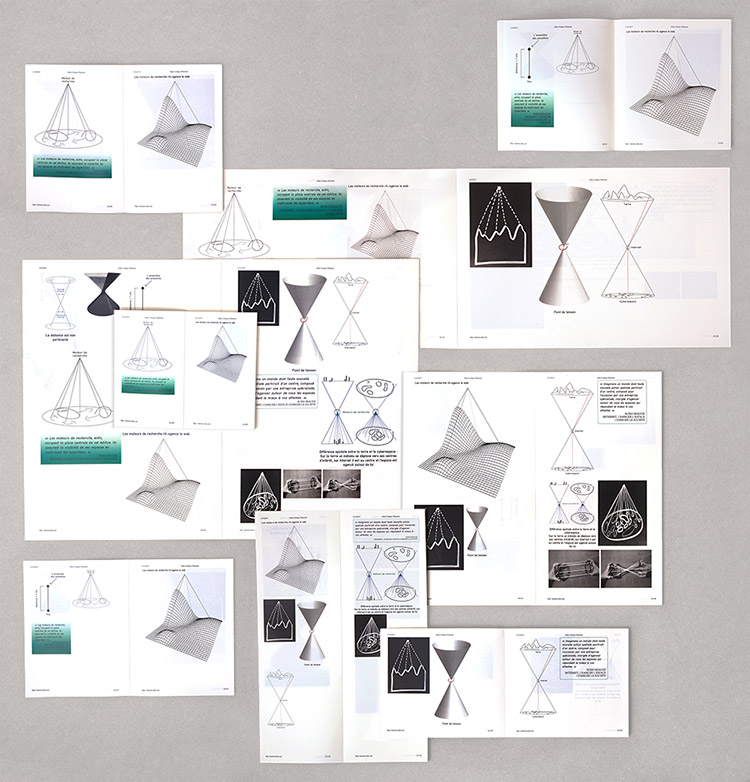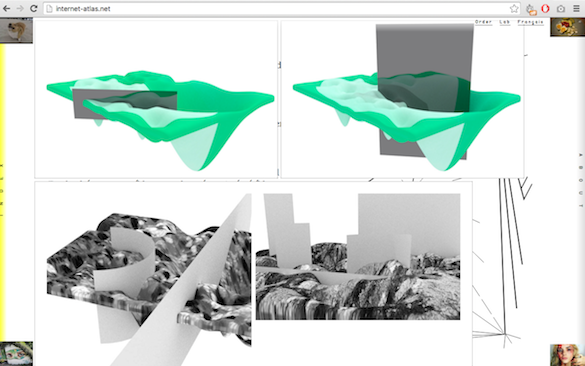



The Critical Atlas of the Internet, Louise Drulhe’s latest project, is a virtual and physical exploration of the Internet space. The implications of our physical actions in ‘real-time’ are not only timeless in ‘cyberspace’, but also constitute the making of an obscure Internet architecture every time we browse the web. The Atlas itself is an enveloping notebook of Drulhe’s discerning methodology in desiring to represent the geography and architecture of the ‘unseen’ Internet territory. Initially, a graphic designer, Drulhe’s practice has meticulously evolved into including cyber-spatial analysis. She yearns to understand the sociological, political and economical issues that appear online or are exasperated by an online presence – ‘a territory we spend time in without knowing its shape’. The Critical Atlas of the Internet, by being parted between fifteen different hypotheses, sheds light on matters such as the monopolisation of non-physical spaces, the possibility of encumbered networks and the potential forms of the Internet.
I had the pleasure of interviewing Drulhe, where she clarified certain distinctive matters that arise from reading or looking at the virtual form of the Atlas online.
CS: In 2014, Google measured 200TB of data that they claim to be just an estimated 0.004% of the total vastness of the Internet. Initially, the Atlas perceives the Internet through many geometric shapes such as cones and spheres. Is this your approach to establishing that the Internet is an infinite space of shared connections and motion? If this is the case, do you believe it is immeasurable?
LD: I will probably get back to you with a better answer to this question in a few months… I am starting an art residency in Paris at La Paillasse, and I will study the question: “can we measure Internet?”. I am curious to see the best way to represent the Internet: to count the data or to measure the borders. I haven’t started this research yet, but I will look for the best unit of measure to calculate the dimensions of Internet territory: meters? Litres? Percentages? Data traffic? I wonder how to define the “size” of a website. If we look at Google.com, it’s only one webpage, so does this mean that Google is smaller than a regular shopping website that might have thousands of pages?
With the fourth hypothesis of the Atlas, “The Geographic Relief of the Internet”, I tried to represent the «size» of Internet platforms. Their size is actually based on the concentration of the activities they host. The Internet giants try to saturate and incorporate as much territory as possible. Google (now called Alphabet) possesses Chrome, Gmail, Android, Google +, YouTube, Blogger, Google Map / Earth / Street View, Cloud, Nest, and Google X… to cite a few. Internet giants are almost raging an online war to monopolize most Internet territory. I think the next virgin land to conquer is the Internet of Things. The map of this 4th hypothesis is based on a ranking by Alexa’s Top 500 Global Sites. What I would like to do next is to measure this representation.
CS: Extrapolating from your claim that the Internet is a single point at the centre of the globe, what would the repercussions if that space were to be encumbered? Can a network not be encumbered?
LD: It’s true. A reticular space cannot be encumbered, I guess. Facebook.com, for instance, is getting more and more popular, but the site works perfectly; you don’t feel crowded situations on Facebook. If Facebook were a physical public square and 1 billion people met there one day, the situation would be really problematic. On Facebook, you never see the crowd.
In the Atlas, I quote Boris Beaude on this idea “The growth of reticular networks, unlike that of cities, increases their interaction potential without boosting their internal distances. Regardless of the network size, the distance between its respective parts is potentially non-existent. Facebook can host 800 million people without affecting its interaction capacity.”[1] This is what he calls “reticular coalescence”.
[1] Boris Beaude, Internet : “Changer l’espace, changer la société“. 2012.
CS: You build your thesis on the hypothesis that Internet space does not require distance; each component is of equal distance to the other. Otherwise, one click away. Whilst this grants no special status to any person’s ‘search’ to being more important or unimportant, aren’t these ‘search results’ always altered depending on the search engine? For example, untracked browsers such as Tor or extensions on Chrome such as ‘Hola’ have the capability to displace a user from their current location and thus materialise a different order by which results appear to us.
LD: I wrote that the search engines “control Internet architecture” and “distribute the space”. Because almost everyone uses Google, we can assume that Google is the one that controls Internet space so if you use another search engine, like “DuckDuckGo”, you will access the web through a different architecture. But “Tor” and “Hola” are not search engines. “Tor” is a network that enables anonymous communication, and “Hola” is a VPN.
By using a VPN, you can bypass censorship. By changing your localisation, the VPN will give you access to another web. There are as many Internets as there are legislations. This idea is represented in the hypothesis, “A Global Object Projected at the Local Level”. The Internet is global, but we use a national projection of the global network. If you are in China, with a VPN, you can browse the Romanian web and access websites censored by the Chinese government. VPNs also enable anonymity, but that’s another aspect of it.

CS: Another one of your hypotheses places us (the users) at the Internet’s centre, constructing the space around us as we move through it. Indeed, the Internet meets our individual needs. Would you, therefore, account for it more as a product – the world’s only flawless consumer good?
LD: Here, I would like to draw your attention to another aspect of my research. If we look at the Internet as a consumer good, it’s probably the first that actually turned consumers into products! In rephrasing one of Mike Edgan’s statements, Jason Fitzpatrick says, “If you are not paying for it, you’re not the customer; you’re the product being sold”. The personal data that are generated through users’ browsing are the new “petrol” of the oncoming economy. And in this particular economy, we won’t be the consumer anymore!
CS: In early forms of the Internet, ‘cyberspaces’ were decentralised. Now, as the Atlas conveys, data is concentrated within the hands of a few ‘heavy players’, illustrated as ‘network nodes’ of various weights burying themselves within the Internet’s surface. Since most of the ‘network nodes’ come from the west, would you consider the Internet to possess a particular Westphalian sovereignty?
LD: The centre of gravity of the Internet is clearly the west, but not, in my opinion, the west as a whole. The US has a dominant position for multiple reasons that I detailed in the Atlas. The Internet’s centre of gravity is defined as “the weight, concentrated solely at one focal point, instead of being distributed over several different points”, a focal point which is undeniably Silicon Valley.

CS: I’d like to ask you about the visual representation of your online Atlas. In particular, about the rigid protrusions of space, you used to convey the ‘splinternet’ and the humorous intrusions of Hilary Clinton and Bernie Sanders, among other seemingly unplanned objects such as fried eggs. Could you comment?
LD: We often imagine the Internet as a single Cloud and a unified territory, but this is wrong. Some multiple limits or frontiers exist online. Some of them are really clear, like the Great Firewall of China: the wall of censorship that divides the Chinese Internet from the rest of the Internet. Another obvious frontier is the limit between the deep web and the surface web. But the frontiers that interested me most were the ones that nobody seemed to pay attention to. The limits are defined by private networks, such as Facebook. People with a Facebook profile never see the frontier because there are always logged in. But when you do not have the password, Facebook is closed, even if some pages are left open to attract you. Their goal is to make you join the private network.
CS: And the unsystematic quirks?
LD: Each time the website loads, the images are automatically taken from the emblematic forum “Reddit”, defined as « the front page of the Internet ». Those images work as timestamps in the Atlas; you can find them at the 4 corners of the website and on the books. The Internet is a perpetually changing space, constantly evolving. It was important for me to bring a timestamp to my Atlas. In addition, these images are symbols of the Internet culture; the Internet meme: viral images spreading through the web and overflowing onto my Atlas.
CS: I’d like to address your citing of Introduction: Rhizome by Guattari and Deleuze. They claim that a rhizome can be connected to anything other and must be’ and therefore does not follow the same arborescent structure of a book or tree. However, as mentioned before, there are arborescent nodes within the Internet itself – the ‘heavy players’. Do you believe this may distract multiplicity or enhance the creation of territories within the Internet? Would you also support that in the case of a rupture, where a rhizome breaks or one of the arborescent nodes fall apart, another node responds to replace as if it was always as such?
LD: Yes, that’s a good comparison. I believe that the heavy players saturate and erode Internet space. This idea is supported by the fact that each company creates a personalized arborescence that is really difficult to connect to by developing its own patterns or ecosystems, like the arborescence of a tree. In this idea, they are breaking with the original shape of the network and its interoperability.
About the rupture, actually, I am not sure. If a node disappears on the network, another node will not necessarily be replaced. If a web page goes offline and at the same time a Facebook page has just been created, the new node (from Facebook) does not take its place. The new node is actually created within the Facebook network. And to refer to my hypothesis about the geographic relief of the Internet, the node opens on the slope of a dominant gap.

CS: As a final point, there’s a particular passage from Baudrillard’s Simulacra and Simulation which I find can be quite relative when considering the structure of the Internet:
“Abstraction today is no longer that of the map, the double, the mirror or the concept. Simulation is no longer that of a territory, a referential being or a substance. It is the generation by models of a real without origin or reality: a hyperreal. The territory no longer precedes the map nor survives it. Henceforth, it is the map that precedes the territory – the precession of simulacra – it is the map that engenders the territory. If we were to revive the fable today, it would be the territory whose shreds are slowly rotting across the map.”
How would you interpret this if we took into consideration Internet territories?
LD: Most people do not consider the Internet as a territory. This idea of cyberspace is a bit old-fashioned. But, I think it is still pertinent today to study the Internet as a real space.
The way we access representations of the Earth today is really magical. Google provides easy access to an extremely precise representation of the Earth through satellite images and maps… But for the territory of the Internet, it’s the opposite. Even if there are a few maps of the Internet, there are no basic tools to map the web. The territory still precedes the map. I would love to see what a Google street view of the Internet looks like!